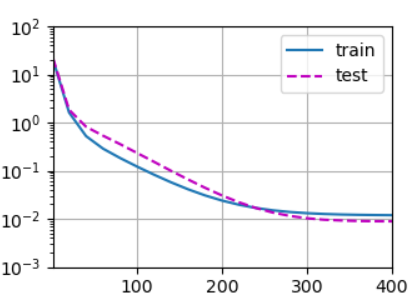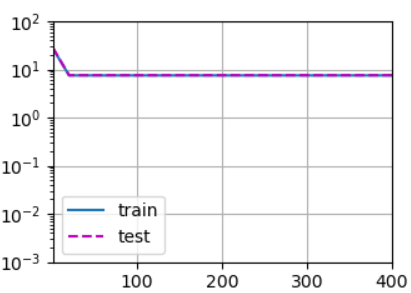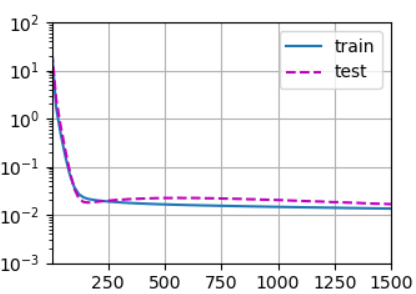4.4.0 头文件
import math
import numpy as np
import torch
from torch import nn
from d2l import torch as d2l
from matplotlib import pyplot as plt
4.4.1利用三阶多项式来制作数据集

# 设置训练集大小和测试集大小
n_train, n_test = 100, 100
# 设置允许的多项式最大阶数(0~19阶),即数据的输入特征最多有20个特征
max_degree = 20
# 设置真实的权重w
true_w = np.zeros(max_degree)
true_w[0:4] = np.array([5, 1.2, -3.4, 5.6]) #按照公式,只设置0~3阶的权重,其他的权重都为零
# 随机生成200个样本x,并将200个样本打乱
features = np.random.normal(size=(n_train + n_test, 1))
np.random.shuffle(features)
# 计算出每隔样本的所有输入特征(包括阶乘)
poly_features = np.power(features, np.arange(max_degree).reshape(1, -1))
for i in range(max_degree):
poly_features[:, i] /= math.gamma(i + 1) # gamma(n)=(n-1)!
# 计算每个样本的真实标签,需要加上噪声
labels = np.dot(poly_features, true_w)
labels += np.random.normal(scale=0.1, size=labels.shape)
# 将真实权重, 样本x, 输入特征, 真实标签转换成张量
true_w, features, poly_features, labels = [torch.tensor(x, dtype=torch.float32) for x in [true_w, features, poly_features, labels]]
4.4.2 计算网络模型在训练集或数据集上的损失均值
# net:定义的网络模型
# data_iter:打乱的并且根据批量大小切割好的训练集或测试集
# loss:损失函数
# 计算网络模型在训练集或数据集上的损失均值
def evaluate_loss(net, data_iter, loss):
metric = d2l.Accumulator(2) #网络模型在训练集或数据集上的损失总和,训练集或测试集的样本总量
for X, y in data_iter:
# 计算一个批量的预测值
out = net(X)
y = y.reshape(out.shape)
# 计算一个批量的损失
l = loss(out, y)
# 将网络模型在训练集或数据集上的损失总和 和 训练集或测试集的样本总量 两个变量累加
metric.add(l.sum(), l.numel())
# 返回网络模型在训练集或数据集上的损失均值
return metric[0] / metric[1]
4.4.3 训练过程
def train(train_features, test_features, train_labels, test_labels,num_epochs=400):
# 定义均方误差损失函数,得到每个样本的损失
loss = nn.MSELoss(reduction='none')
input_shape = train_features.shape[-1] #训练集一个100个样本,每个样本有input_shape个输入特征
# 定义网络模型,网络模型中只有一个全连接层,全连接层input_shape个输入,一个输出,不设置偏移量,因为input_shape个特征中有一个特征对应的是偏移量
net = nn.Sequential(nn.Linear(input_shape, 1, bias=False))
# 设置批量大小为10
batch_size = min(10, train_labels.shape[0])
# 获取经过按照批量大小进行切割和封装过的训练集,可迭代读取,每次迭代读取出一个批量的数据(特征 + 对应的标签)
train_iter = d2l.load_array((train_features, train_labels.reshape(-1,1)), batch_size)
# 获取经过按照批量大小进行切割和封装过的测试集,可迭代读取,每次迭代读取出一个批量的数据(特征 + 对应的标签)
test_iter = d2l.load_array((test_features, test_labels.reshape(-1,1)),batch_size, is_train=False)
# 定义优化器
trainer = torch.optim.SGD(net.parameters(), lr=0.01)
# 定义动画,显示训练结果
animator = d2l.Animator(xlabel='epoch', ylabel='loss', yscale='log',xlim=[1, num_epochs], ylim=[1e-3, 1e2],legend=['train', 'test'])
# 进行400轮训练
for epoch in range(num_epochs):
# 进行一轮训练
d2l.train_epoch_ch3(net, train_iter, loss, trainer)
# 每隔20轮,将训练得到的模型在训练集和测试集上分别计算一次损失(训练损失、泛化损失)
if epoch == 0 or (epoch + 1) % 20 == 0:
animator.add(epoch + 1, (evaluate_loss(net, train_iter, loss),evaluate_loss(net, test_iter, loss)))
# 输出训练得到的模型权重
print('weight:', net[0].weight.data.numpy())
# 用三阶多项式来拟合模型(正常)
# poly_features[:n_train, :4]:将前100个样本在每个阶数的特征值作为训练集(用三阶来拟合,所以只取前4个特征)
# poly_features[n_train:, :4]:将后100个样本在每个阶数的特征值作为训练集(用三阶来拟合,所以只取前4个特征)
# labels[:n_train]:将前100个样本的输出值作为训练集标签
# labels[n_train:]:将后100个样本的输出值作为测试集标签
train(poly_features[:n_train, :4], poly_features[n_train:, :4],labels[:n_train], labels[n_train:])
# 输出:
# weight: [[ 5.015506 1.2249223 -3.3873422 5.5354605]]
# 用一阶多项式来拟合模型(欠拟合)
# poly_features[:n_train, :2]:将前100个样本在每个阶数的特征值作为训练集(用一阶来拟合,所以只取前2个特征)
# poly_features[n_train:, :2]:将后100个样本在每个阶数的特征值作为训练集(用一阶来拟合,所以只取前2个特征)
# labels[:n_train]:将前100个样本的输出值作为训练集标签
# labels[n_train:]:将后100个样本的输出值作为测试集标签train(poly_features[:n_train, :2], poly_features[n_train:, :2],labels[:n_train], labels[n_train:])
# 输出:
# weight: [[3.4878697 3.5113552]]
# 用十九阶多项式来拟合模型(过拟合)
# poly_features[:n_train, :]:将前100个样本在每个阶数的特征值作为训练集(用十九阶来拟合,所以取前20个特征)
# poly_features[n_train:, :]:将后100个样本在每个阶数的特征值作为训练集(用十九阶来拟合,所以只取前20个特征)
# labels[:n_train]:将前100个样本的输出值作为训练集标签
# labels[n_train:]:将后100个样本的输出值作为测试集标签train(poly_features[:n_train, :], poly_features[n_train:, :],labels[:n_train], labels[n_train:], num_epochs=1500)
# 输出:
# weight: [[ 4.99926233e+00 1.25115871e+00 -3.30954051e+00 5.25334406e+00
# -1.84362158e-01 1.19941306e+00 -1.35312080e-01 3.56987506e-01
# -4.66701621e-03 -2.12772131e-01 -3.00819799e-02 2.23305166e-01
# -1.01899929e-01 -2.07265347e-01 2.22946733e-01 -1.81735992e-01
# -1.20312020e-01 1.53819770e-01 -1.10108346e-01 1.31270021e-01]]



本小节完整代码如下所示
import math
import numpy as np
import torch
from torch import nn
from d2l import torch as d2l
from matplotlib import pyplot as plt
# ------------------------------利用三阶多项式来制作数据集------------------------------------
# 设置训练集大小和测试集大小
n_train, n_test = 100, 100
# 设置允许的多项式最大阶数(0~19阶),即数据的输入特征最多有20个特征
max_degree = 20
# 设置真实的权重w
true_w = np.zeros(max_degree)
true_w[0:4] = np.array([5, 1.2, -3.4, 5.6]) #按照公式,只设置0~3阶的权重,其他的权重都为零
# 随机生成200个样本x,并将200个样本打乱
features = np.random.normal(size=(n_train + n_test, 1))
np.random.shuffle(features)
# 计算出每隔样本的所有输入特征(包括阶乘)
poly_features = np.power(features, np.arange(max_degree).reshape(1, -1))
for i in range(max_degree):
poly_features[:, i] /= math.gamma(i + 1) # gamma(n)=(n-1)!
# 计算每个样本的真实标签,需要加上噪声
labels = np.dot(poly_features, true_w)
labels += np.random.normal(scale=0.1, size=labels.shape)
# 将真实权重, 样本x, 输入特征, 真实标签转换成张量
true_w, features, poly_features, labels = [torch.tensor(x, dtype=torch.float32) for x in [true_w, features, poly_features, labels]]
# ------------------------------计算网络模型在训练集或数据集上的损失均值------------------------------------
# net:定义的网络模型
# data_iter:打乱的并且根据批量大小切割好的训练集或测试集
# loss:损失函数
# 计算网络模型在训练集或数据集上的损失均值
def evaluate_loss(net, data_iter, loss):
metric = d2l.Accumulator(2) #网络模型在训练集或数据集上的损失总和,训练集或测试集的样本总量
for X, y in data_iter:
# 计算一个批量的预测值
out = net(X)
y = y.reshape(out.shape)
# 计算一个批量的损失
l = loss(out, y)
# 将网络模型在训练集或数据集上的损失总和 和 训练集或测试集的样本总量 两个变量累加
metric.add(l.sum(), l.numel())
# 返回网络模型在训练集或数据集上的损失均值
return metric[0] / metric[1]
# ------------------------------训练过程------------------------------------
def train(train_features, test_features, train_labels, test_labels,num_epochs=400):
# 定义均方误差损失函数,得到每个样本的损失
loss = nn.MSELoss(reduction='none')
input_shape = train_features.shape[-1] #训练集一个100个样本,每个样本有input_shape个输入特征
# 定义网络模型,网络模型中只有一个全连接层,全连接层input_shape个输入,一个输出,不设置偏移量,因为input_shape个特征中有一个特征对应的是偏移量
net = nn.Sequential(nn.Linear(input_shape, 1, bias=False))
# 设置批量大小为10
batch_size = min(10, train_labels.shape[0])
# 获取经过按照批量大小进行切割和封装过的训练集,可迭代读取,每次迭代读取出一个批量的数据(特征 + 对应的标签)
train_iter = d2l.load_array((train_features, train_labels.reshape(-1,1)), batch_size)
# 获取经过按照批量大小进行切割和封装过的测试集,可迭代读取,每次迭代读取出一个批量的数据(特征 + 对应的标签)
test_iter = d2l.load_array((test_features, test_labels.reshape(-1,1)),batch_size, is_train=False)
# 定义优化器
trainer = torch.optim.SGD(net.parameters(), lr=0.01)
# 定义动画,显示训练结果
animator = d2l.Animator(xlabel='epoch', ylabel='loss', yscale='log',xlim=[1, num_epochs], ylim=[1e-3, 1e2],legend=['train', 'test'])
# 进行400轮训练
for epoch in range(num_epochs):
# 进行一轮训练
d2l.train_epoch_ch3(net, train_iter, loss, trainer)
# 每隔20轮,将训练得到的模型在训练集和测试集上分别计算一次损失(训练损失、泛化损失)
if epoch == 0 or (epoch + 1) % 20 == 0:
animator.add(epoch + 1, (evaluate_loss(net, train_iter, loss),evaluate_loss(net, test_iter, loss)))
# 输出训练得到的模型权重
print('weight:', net[0].weight.data.numpy())
# 用三阶多项式来拟合模型(正常)
# poly_features[:n_train, :4]:将前100个样本在每个阶数的特征值作为训练集(用三阶来拟合,所以只取前4个特征)
# poly_features[n_train:, :4]:将后100个样本在每个阶数的特征值作为训练集(用三阶来拟合,所以只取前4个特征)
# labels[:n_train]:将前100个样本的输出值作为训练集标签
# labels[n_train:]:将后100个样本的输出值作为测试集标签
# train(poly_features[:n_train, :4], poly_features[n_train:, :4],labels[:n_train], labels[n_train:])
# 输出:
# weight: [[ 5.015506 1.2249223 -3.3873422 5.5354605]]
# 用一阶多项式来拟合模型(欠拟合)
# poly_features[:n_train, :2]:将前100个样本在每个阶数的特征值作为训练集(用一阶来拟合,所以只取前2个特征)
# poly_features[n_train:, :2]:将后100个样本在每个阶数的特征值作为训练集(用一阶来拟合,所以只取前2个特征)
# labels[:n_train]:将前100个样本的输出值作为训练集标签
# labels[n_train:]:将后100个样本的输出值作为测试集标签
# train(poly_features[:n_train, :2], poly_features[n_train:, :2],labels[:n_train], labels[n_train:])
# 输出:
# weight: [[3.4878697 3.5113552]]
# 用十九阶多项式来拟合模型(过拟合)
# poly_features[:n_train, :]:将前100个样本在每个阶数的特征值作为训练集(用十九阶来拟合,所以取前20个特征)
# poly_features[n_train:, :]:将后100个样本在每个阶数的特征值作为训练集(用十九阶来拟合,所以只取前20个特征)
# labels[:n_train]:将前100个样本的输出值作为训练集标签
# labels[n_train:]:将后100个样本的输出值作为测试集标签
train(poly_features[:n_train, :], poly_features[n_train:, :],labels[:n_train], labels[n_train:], num_epochs=1500)
# 输出:
# weight: [[ 4.99926233e+00 1.25115871e+00 -3.30954051e+00 5.25334406e+00
# -1.84362158e-01 1.19941306e+00 -1.35312080e-01 3.56987506e-01
# -4.66701621e-03 -2.12772131e-01 -3.00819799e-02 2.23305166e-01
# -1.01899929e-01 -2.07265347e-01 2.22946733e-01 -1.81735992e-01
# -1.20312020e-01 1.53819770e-01 -1.10108346e-01 1.31270021e-01]]
# ------------------------------训练结果可视化------------------------------------
plt.savefig('Output.png')





 浙公网安备 33010602011771号
浙公网安备 33010602011771号